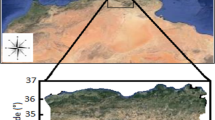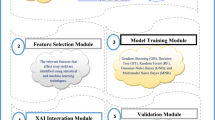Abstract
Rice cultivation demands adequate soil water balance in each growth stage and estimation of evapotranspiration and soil moisture are the most contributing factors for determining this. Evapotranspiration prediction is essential as it indicates rice water demand in advance depending on several environmental conditions and soil moisture prediction helps to judiciously schedule irrigation based on soil water balance. Several environmental parameters are having impact on evapotranspiration and soil moisture prediction. In order to select correlated environmental parameters with evapotranspiration and soil moisture, salp swarm algorithm which is improved using opposition based learning, local search algorithm, and a control parameter called inertia weight (ISSA) is used. Feature Weighted K-Nearest Neighbor is consolidated with ISSA to assess the quality of selected environmental parameters. Evapotranspiration is predicted using individual machine learning models and ensemble learning but individual machine learning models suffers from high bias and variance in prediction and cannot provide the desired prediction accuracy. Boosting outperform all the models with Mean Absolute Error (MAE) [0.10, 0.03, 0.05], Mean Squared Error (MSE) [0.15, 0.09, 0.109], Root Mean Square Error (RMSE) [0.387, 0.300, 0.330], Nash Sutcliffe Efficiency (NSE) [0.959, 0.948, 0.692] and Coefficient of determination (\(R^{2}\)) [0.962, 0.941, 0.697] for evapotranspiration prediction in vegetative, reproductive and ripening growth stages respectively using selected features. Soil moisture is also predicted where Boosting also outperforms other methods with MAE [0.168, 0.131, 0.08], MSE [0.425, 0.142, 0.128], RMSE [0.651, 0.376, 0.357], NSE [0.912, 0.928, 0.698] and \(R^{2}\) [0.918, 0.932, 0.717] in every rice growth stage using selected features.











Similar content being viewed by others
Data availability
No codes are made available for sharing at present.
Code availability
Data will be made available on request.
References
Agrawal Y, Kumar M, Ananthakrishnan S et al (2022) Evapotranspiration modeling using different tree based ensembled machine learning algorithm. Water Resour Manage 36(3):1025–1042. https://doi.org/10.1007/s11269-022-03067-7
Ahmadianfar I, Heidari AA, Gandomi AH et al (2021) Run beyond the metaphor: An efficient optimization algorithm based on Runge Kutta method. Expert Syst Appl 181:115079. https://doi.org/10.1016/j.eswa.2021.115079
Ahmadianfar I, Heidari AA, Noshadian S et al (2022) Info: An efficient optimization algorithm based on weighted mean of vectors. Expert Syst Appl 195:116516. https://doi.org/10.1016/j.eswa.2022.116516
Allen RG, Pereira LS, Raes D et al (1998) Crop evapotranspiration-guidelines for computing crop water requirements-FAO irrigation and drainage paper 56. FAO, Rome 300(9):D05109
Banik R, Das P, Ray S et al (2021) Prediction of electrical energy consumption based on machine learning technique. Electr Eng 103(2):909–920. https://doi.org/10.1007/s00202-020-01126-z
Bauer E, Kohavi R (1999) An empirical comparison of voting classification algorithms: Bagging, boosting, and variants. Mach Learn 36(1):105–139
Benesty J, Chen J, Huang Y et al (2009) Pearson correlation coefficient. Noise Reduction in Speech Processing pp 1–4. https://doi.org/10.1007/978-3-642-00296-0_5
Chen D, Gao G, Xu CY et al (2005) Comparison of the thornthwaite method and pan data with the standard Penman-Monteith estimates of reference evapotranspiration in China. Climate Res 28(2):123-132. https://doi.org/10.3354/cr028123
Derrac J, Garcia S, Molina D et al (2011) A practical tutorial on the use of nonparametric statistical tests as a methodology for comparing evolutionary and swarm intelligence algorithms. Swarm Evol Comput 1(1):3–18. https://doi.org/10.1007/978-3-642-00296-0_5
Ding H, Cao X, Wang Z et al (2022) Velocity clamping-assisted adaptive salp swarm algorithm: balance analysis and case studies. Math Biosci Eng 19(8):7756–7804. https://doi.org/10.3934/mbe.2022364
Eberhart RC, Shi YH (2001) Tracking and optimizing dynamic systems with particle swarms. Congress on Evolutionary Computation, Korea. https://doi.org/10.1109/CEC.2001.934376
Filipovic N, Brdar S, Mimic G et al (2022) Regional soil moisture prediction system based on long short-term memory network. Biosys Eng 213:30–38
Goap A, Sharma D, Shukla AK et al (2021) An iot based smart irrigation management system using machine learning and open source technologies. Comput Electron Agric 155:41–49. https://doi.org/10.1016/j.procs.2020.03.440
Hegazy AE, Makhlouf MA, El-Tawel GS (2020) Improved Salp swarm algorithm for feature selection. J King Saud Univ - Comput Inf Sci 32(3):335–344. https://doi.org/10.1016/j.jksuci.2018.06.003
Heidari AA, Mirjalili S, Faris H et al (2019) Harris hawks optimization: Algorithm and applications. Futur Gener Comput Syst 97:849–872. https://doi.org/10.1016/j.future.2019.02.028
Houssein EH, Helmy BED, Rezk H et al (2022) An efficient orthogonal opposition-based learning slime mould algorithm for maximum power point tracking. Neural Comput Appl 34(5):3671–3695. https://doi.org/10.1007/s00521-021-06634-y
Hussien A (2022) An enhanced opposition-based salp swarm algorithm for global optimization and engineering problems. J Ambient Intell Human Comput 13:129–150. https://doi.org/10.1007/s12652-021-02892-9
Li S, Chen H, Wang M et al (2020) Slime mould algorithm: a new method for stochastic optimization. Futur Gener Comput Syst 111:300–323. https://doi.org/10.1016/j.future.2020.03.055
Li X, Wang K, Liu L et al (2011) Application of the entropy weight and topsis method in safety evaluation of coalmines. Procedia Eng 26:2085–2091. https://doi.org/10.1016/j.proeng.2011.11.2410
Luo W, Chen M, Kang Y et al (2022) Analysis of crop water requirements and irrigation demands for rice: Implications for increasing effective rainfall. Agric Water Manag 260:107285. https://doi.org/10.1016/j.agwat.2021.107285
Mirjalili S (2015) Moth-flame optimization algorithm: a novel nature-inspired heuristic paradigm. Knowl-Based Syst 89:28–249. https://doi.org/10.1016/j.knosys.2015.07.006
Mirjalili S, Mirjalili S, Lewis A (2014) Grey wolf optimizer. Adv Eng Softw 69:46–61. https://doi.org/10.1016/j.advengsoft.2013.12.007
Mirjalili S, Gandomi AH, Mirjalili SZ et al (2017) Salp swarm algorithm: a bio-inspired optimizer for engineering design problems. Adv Eng Softw 114:163–191. https://doi.org/10.1016/j.advengsoft.2017.07.002
Mohammad A, Sudhishri S, Das T et al (2018) Water balance in direct-seeded rice under conservation agriculture in north-western indo-gangetic plains of india. Irrig Sci 36(6):381–393. https://doi.org/10.1007/s00271-018-0590-z
Moriasi DN, Gitau MW, Pai N et al (2005) Hydrologic and water quality models: performance measures and evaluation criteria. Transactions of the American Society of Agricultural and Biological Engineers 58:1763–1785
Munir MS, Bajwa IS, Cheema SM (2020) An intelligent and secure smart watering system using fuzzy logic and block chain. Comput Electr Eng 77:109–119. https://doi.org/10.1016/j.compeleceng.2019.05.006
Rana G, Katerji N (2000) Measurement and estimation of actual evapotranspiration in the field under mediterranean climate: a review. Eur J Agron 13(2–3):125–153. https://doi.org/10.1016/S1161-0301(00)00070-8
Roy DK (2021) Long short-term memory networks to predict one-step ahead reference evapotranspiration in a subtropical climatic zone. Environ Process 8(2):911–941. https://doi.org/10.1007/s40710-021-00512-4
Roy DK, Saha KK, Kamruzzaman M et al (2021) Hierarchical fuzzy systems integrated with particle swarm optimization for daily reference evapotranspiration prediction: a novel approach. Water Resour Manag 1–25. https://doi.org/10.1007/s11269-021-03009-9
Saggi MK, Jain S (2020) Application of fuzzy-genetic and regularization random forest (FGRRF): estimation of crop evapotranspiration (ETC) for maize and wheat crops. Agric Water Manag 229:105907. https://doi.org/10.1016/j.agwat.2019.105907
Singh N, Houssein EH, Singh SB et al (2022) Hssahho: a novel hybrid Salp Swarm-Harris Hawks optimization algorithm for complex engineering problems. J Ambient Intell Humaniz Comput 1–37. https://doi.org/10.1007/s12652-022-03724-0
Sivakumar B, Nanjundaswamy C (2021) Weather monitoring and forecasting system using IoT. Glob J Eng Technol Adv 8(2):8–16
Tian B, Yang Y, Li D et al (2010) A security framework for wireless sensor networks. J China U Posts Telecommun 17(2):118–122. https://doi.org/10.1016/S1005-8885(09)60571-9
Tu J, Chen H, Wang M et al (2021) The colony predation algorithm. J Bionic Eng 18(3):674–710. https://doi.org/10.1007/s42235-021-0050-y
Tubishat M, Idris N, Shuib L et al (2020) Improved salp swarm algorithm based on opposition based learning and novel local search algorithm for feature selection. Expert Syst Appl 145:113–122. https://doi.org/10.1016/j.eswa.2019.113122
Unes F, Kaya YZ, Mamak M (2022) Daily reference evapotranspiration prediction based on climatic conditions applying different data mining techniques and empirical equations. Theoret Appl Climatol 141(1):763–773. https://doi.org/10.1007/s00704-020-03225-0
Vergara BS (1991) Rice plant growth and development. RiceSpringer, Boston, MA pp 13–22. https://doi.org/10.1007/978-1-4899-3754-4_2
Verstraeten WW, Veroustraete F, Feyen J (2021) Assessment of evapotranspiration and soil moisture content across different scales of observation. Sensors 8(1):70–117. https://doi.org/10.3390/s8010070
Vij A, Vijendra S, Jain A et al (2020) Iot and machine learning approaches for automation of farm irrigation system. Procedia Computer Science 167:1250–1257. https://doi.org/10.1016/j.procs.2020.03.440
Wang C, Xu RQ, Ma L et al (2023) An efficient Aalp swarm algorithm based on scale-free informed followers with self-adaption weight. Appl Intell 53:1759–1791
Wang G, Deb S, Cui Z (2019) Monarch butterfly optimization. Neural Comput Applic 31:1995–2014. https://doi.org/10.1007/s00521-015-1923-y
Wang Z, Ding H, Wang J et al (2022a) Adaptive guided Salp swarm algorithm with velocity clamping mechanism for solving optimization problems. J Comput Des Eng 9(6):2196–2234. https://doi.org/10.1093/jcde/qwac094/6696965
Wang Z, Ding H, Yang J et al (2022b) Advanced orthogonal opposition–based learning-driven dynamic Salp swarm algorithm: framework and case studies. IET Control Theory Appl. https://doi.org/10.1049/cth2.12277
Wang Z, Ding H, Yang Z et al (2022c) Rank-driven Salp swarm algorithm with orthogonal opposition-based learning for global optimization. Appl Intell 52(7):7922–7964. https://doi.org/10.1007/s10489-021-02776-7
Wolpert D, Macready W (1997) No free lunch theorems for optimization. IEEE Trans Evol Comput 1:67–82. https://doi.org/10.1109/4235.585893
Wu J, Sun J, Liang L et al (2011) Determination of weights for ultimate cross efficiency using shannon entropy. Expert Syst Appl 38:5162-5165. https://doi.org/10.1016/j.eswa.2010.10.046
Xie W, Xue W (2021) Wb-knn for emotion recognition from physiological signals. Optoelectron Lett 17(7):444–448. https://doi.org/10.1007/s11801-021-0118-2
Yang Y, Chen H, Heidari AA et al (2021) Hunger games search: visions, conception, implementation, deep analysis, perspectives, and towards performance shifts. Expert Syst Appl 177. https://doi.org/10.1016/j.eswa.2021.114864
Ye L, Zahra MMA, Al-Bedyry NK et al (2022) Daily scale evapotranspiration prediction over the coastal region of southwest bangladesh: new development of artificial intelligence model. Stoch Env Res Risk Assess 36(2):451–471. https://doi.org/10.1007/s00477-021-02055-4
Yin H, Gai K, Wang Z (2016) A classification algorithm based on ensemble feature selections for imbalanced-class dataset. IEEE 2nd International Conference on Big Data Security on Cloud (BigDataSecurity), IEEE International Conference on High Performance and Smart Computing (HPSC), and IEEE International Conference on Intelligent Data and Security (IDS) pp 245–249. https://doi.org/10.1109/BigDataSecurity-HPSC-IDS.2016.76
Zhai Z, Martinez JF, Beltran V et al (2020) Decision support systems for agriculture 4.0: Survey and challenges. Comput Electron Agric 105256:170. https://doi.org/10.1016/j.compag.2020.105256
Zotarelli L, Dukes MD, Romero CC et al (2010) Step by step calculation of the penman monteith evapotranspiration (FAO-56 method). Agricultural and Biological Engineering Department, UF/IFAS Extension, USDA p AE459
Author information
Authors and Affiliations
Contributions
Conceptualization: Parijata Majumdar and Sanjoy Mitra. Methodology: Parijata Majumdar. Formal analysis and investigation: Sanjoy Mitra and Parijata Majumdar. Data curation and software: Parijata Majumdar and Diptendu Bhattacharya. Validation: Sanjoy Mitra. Visualization: Diptendu Bhattacharya and Parijata Majumdar. Writing — original draft preparation: Parijata Majumdar and Sanjoy Mitra. Writing — review and editing: Sanjoy Mitra. Supervision: Diptendu Bhattacharya and Sanjoy Mitra. Funding acquisition: not applicable. Resources: Sanjoy Mitra and Diptendu Bhattacharya
Corresponding author
Ethics declarations
Ethics approval
This research does not involve human participants and/or animals. Hence, ethics approval not required.
Consent to participate
As this research does not involve human participants and/or animals, hence, consent to participate not applicable.
Consent for publication
As this research does not involve human participants and/or animals, hence, consent for publication not applicable.
Competing Interests
The authors declare no competing interests.
Additional information
Publisher's Note
Springer Nature remains neutral with regard to jurisdictional claims in published maps and institutional affiliations.
Rights and permissions
Springer Nature or its licensor (e.g. a society or other partner) holds exclusive rights to this article under a publishing agreement with the author(s) or other rightsholder(s); author self-archiving of the accepted manuscript version of this article is solely governed by the terms of such publishing agreement and applicable law.
About this article
Cite this article
Majumdar, P., Bhattacharya, D. & Mitra, S. Prediction of evapotranspiration and soil moisture in different rice growth stages through improved salp swarm based feature optimization and ensembled machine learning algorithm. Theor Appl Climatol 153, 649–673 (2023). https://doi.org/10.1007/s00704-023-04414-3
Received:
Accepted:
Published:
Issue Date:
DOI: https://doi.org/10.1007/s00704-023-04414-3




